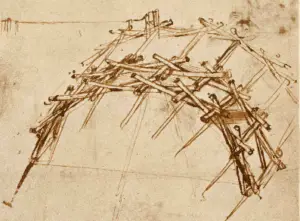
What Is the Da Vinci Self-Supporting Bridge?
A Masterpiece of Balance and Ingenuity
Leonardo da Vinci self-supporting bridge is an engineering marvel from the Renaissance. Unlike traditional bridges, it doesn’t need nails, ropes, or fasteners.
It stands purely through balance and clever design. This bridge captures Leonardo’s ability to merge art, science, and functionality in a single masterpiece.
How Does the Da Vinci Bridge Work?
The Secrets of Tension and Compression
The bridge works by using tension and compression. Logs or beams interlock to create an arch that supports itself. Each piece presses against its neighbors, holding the whole structure together.
This approach distributes weight evenly, eliminating the need for additional support materials.
Leonardo’s Mathematical Precision
Leonardo mastered geometry and natural forces to create this design. He carefully calculated each angle and placement.
His work demonstrates his profound understanding of the world around him, encompassing anatomy and flight.
Historical Context: Why Leonardo Designed the Bridge
Military Innovation and Practical Needs
Leonardo created this bridge while working as a military engineer for Cesare Borgia. His goal was to help troops cross rivers quickly and safely.
The bridge could be assembled fast, carried efficiently, and dismantled after use. This gave armies a considerable advantage.
A Vision Beyond the Battlefield
Leonardo’s connection to the Medici family also supported his bold ideas. He saw bridges not just as military tools but as symbols of connection and progress.
Leonardo even designed a giant bridge for the Golden Horn in Istanbul. Though it was never built, it showed his forward-thinking approach. His ideas would inspire architects and engineers for centuries to come.
Modern Reconstructions and Global Influence
Bringing Leonardo’s Vision to Life
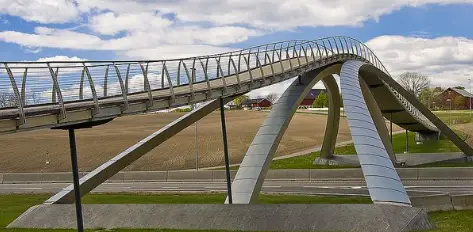
Leonardo never built the original bridge himself. But today, people around the world have brought his vision to life. The full-scale pedestrian bridge in Ås, Norway, finished in 2001, proves that his design works in reality.
Education and Interactive Displays
Museums and science centers often feature smaller models. These hands-on displays help people of all ages understand how the bridge stands. Some universities use it to teach future architects and engineers about simplicity and balance.
How to Build A Leonardo Da Vinci Bridge Popsicle Sticks (DIY Guide)
Fun, Educational, and Hands-On
Building a Da Vinci bridge at home or in the classroom is fun and educational. You can use popsicle sticks, pencils, or even wooden dowels.
Materials you’ll need:
- Popsicle sticks (about 20–30 or more, depending on your desired length)
- A flat surface (like a desk or table)
- Patience and a curious spirit!
Da Vinci Bridge Instructions (step-by-step guide)
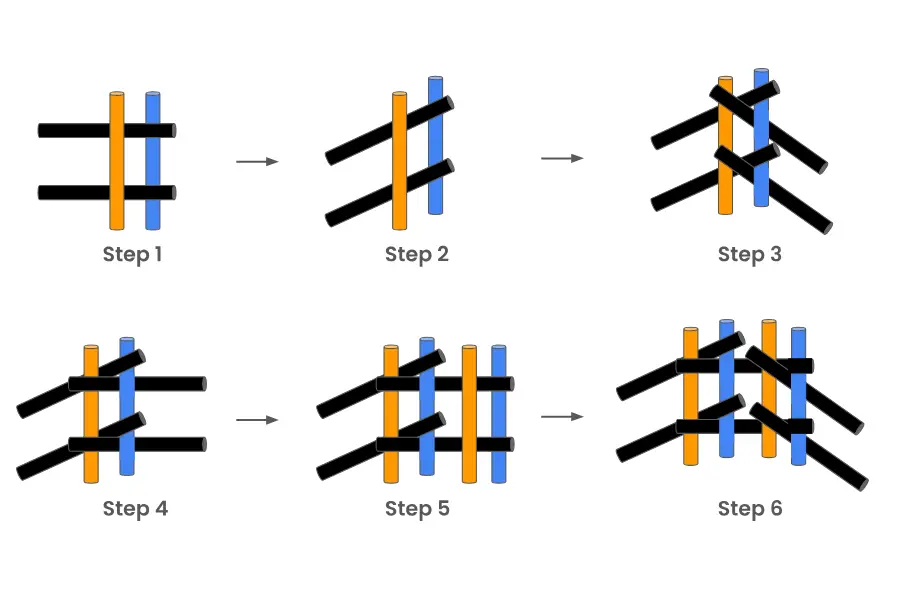
Step 1: Arrange your base sticks.
Place four popsicle sticks on a flat surface, parallel and evenly spaced. In your guide, these are shown with the orange side up and the blue side down to help visualize orientation.
Step 2: Lift the base.
Gently lift the parallel sticks slightly off the surface. This begins creating the arch shape and allows weaving to start smoothly.
Step 3: Insert two cross sticks.
From the right side, weave two black popsicle sticks through the lifted structure. These sticks secure the base together and form the first layer of crossing.
Step 4: Lift again.
Carefully lift the structure higher to create space and tension for the next set of sticks. This helps stabilize the early framework.
Step 5: Add two more parallel sticks.
Place two additional popsicle sticks on top, parallel to the original base sticks, with the same orange side up and blue side down. This starts creating the layered arch.
Step 6: Weave in two more cross sticks.
From the right side again, insert two more black sticks, weaving them through the new parallel sticks. By this point, the structure should start to hold itself — this is the self-supporting stage.
Repeat and extend.
Repeat Steps 5 and 6 as many times as you’d like to extend the bridge. Each additional layer makes it longer and stronger.
Test and fine-tune.
Once your bridge stands on its own, carefully test it by placing small objects on top of it. Watch how the forces distribute and adjust if needed. Try different lengths or angles to explore how the design changes.
Tips:
- Use smooth, sturdy sticks for better stability and easier weaving.
- Move slowly and gently when lifting or weaving to avoid collapse.
- Challenge yourself by using pencils, chopsticks, or dowels for a different style!
Download our free step-by-step illustrated PDF guide to build your own Da Vinci bridge at home or in class!
Applications in Education and Engineering
Teaching Balance and Design Thinking
Leonardo’s bridge helps students learn about balance, geometry, and design thinking. By building it, they see how forces work together to create stability.
Real-World Engineering Inspiration
In real-world engineering, his principles inspire the rapid assembly of bridges used during emergencies or military operations. Modern architects also borrow from his focus on simplicity and natural strength.
His design even connects to modular and prefabricated construction methods today. Over 500 years later, Leonardo’s ideas still guide engineers and architects.
Cultural and Artistic Significance
A Symbol of Beauty and Connection
The Da Vinci bridge is more than an engineering feat. It’s an artistic statement. Its graceful arches and clean lines reflect Renaissance ideals of harmony and beauty.
Artists and architects use this form in modern sculptures and public installations. The bridge symbolizes connection, resilience, and the endless potential of human creativity.
Leonardo’s Other Bridge Innovations
Beyond the Self-Supporting Bridge: Military and Mobile Designs
Leonardo called it the “Bridge of Safety.” The da Vinci Bridge was just one of the ingenious structures he had designed throughout his life.
He also invented several other bridges, including a revolving bridge that, according to Leonardo da Vinci, “could be quickly packed and transported to enable fleeing armies to cross waters,” “cross streams or moats, put the bridge on the other side for easy passage of soldiers” and “fitted with a system of ropes and pulleys for quick deployment and easy transport.”
These tools are helpful for those who once aspired to military supremacy in Italy, but they are more useful for 21st-century Renaissance individuals.
11 Interesting Facts about the Da Vinci Bridge
1) What inspired Leonardo da Vinci to design a bridge spanning the Golden Horn in Istanbul?
One of Leonardo da Vinci’s most famous architectural designs is a bridge spanning the Golden Horn in Istanbul, Türkiye.
The Golden Horn played a significant role in the Ottoman Empire. In the late 15th century, Sultan Bayezid II asked Leonardo da Vinci to design a bridge over the harbor.
Inspired by the beauty and importance of the Golden Horn, Leonardo da Vinci envisioned a functional, aesthetically pleasing, sturdy, and graceful bridge with a simple and elegant design.
Despite its simplicity, the design was highly innovative. It used a series of arches and buttresses to support the bridge, which would have made it one of the most stable bridges of its era.

Unfortunately, the design was never built, but modern engineering and technology have made it possible to construct Leonardo da Vinci’s bridge design today, allowing us to appreciate its genius.
The Golden Horn bridge design (Leonardo da Vinci’s self-supporting bridge design) inspires architects and engineers worldwide, setting a high standard for bridge design that continues to influence the field.
2) What is unique about the Da Vinci Bridge?
The Da Vinci Bridge is known for its innovative and unconventional design. Unlike traditional bridges, which rely on solid supports and multiple structural elements, this bridge is a self-supporting arch made entirely from interlocking wooden planks.
Its simplicity and elegance make it a remarkable feat in both engineering and architecture.
3) How does the Da Vinci bridge work?
The bridge’s design is based on the principle of compression and tension forces. The self-supporting arch distributes the bridge’s weight evenly, utilizing the structure’s inherent strength.
The forces are balanced by precisely arranging the planks, allowing the bridge to stand without external support.
4) Did Da Vinci build a bridge?
Although Leonardo da Vinci is renowned for his drawings and sketches of the bridge, there is no historical evidence that he constructed it himself.
However, his detailed drawings and concepts demonstrate his deep understanding of engineering and ability to envision groundbreaking structures.
5) Where is the Da Vinci Bridge located?
One of the surviving replicas of the da Vinci bridge can be found in the town of Ås, Norway.
The bridge, built in 2001, is a testament to its lasting legacy. It is based on Leonardo’s original design.
6) Why is the Da Vinci Bridge so strong?
The strength of the da Vinci bridge lies in its unique geometric design. The interlocking structure distributes the weight evenly, enabling the bridge to withstand heavy loads.
The arch shape and the compression forces along the curved structure ensure its stability and resilience.
7) What is the most interesting thing about Leonardo da Vinci?
One of Leonardo da Vinci’s most fascinating aspects is his ability to bridge the gap between art and science. He was a masterful painter, a prolific inventor, an engineer, and an anatomist.
His insatiable curiosity and passion for knowledge allowed him to make groundbreaking contributions in various fields, leaving an indelible mark on history, as supported by his famous quotes.
8) How did Leonardo da Vinci’s design influence modern bridge engineering?
Leonardo da Vinci’s design for the Golden Horn Bridge in Istanbul, Türkiye, has had a profound impact on modern bridge engineering. Although it was created over 500 years ago, it remains relevant and inspiring to engineers today.
Leonardo da Vinci’s innovative use of arches and buttresses to support the bridge was ahead of its time. It helped set a standard for bridge design that continues to influence the field.
Leonardo da Vinci’s principles of stability and simplicity, which he applied in his bridge design, remain influential in modern bridge construction worldwide.
Today’s engineers have built upon Leonardo da Vinci’s ideas and incorporated new materials and technologies to create stronger, more durable bridges.
9) What challenges did Leonardo da Vinci face when creating his bridge design for the Golden Horn?
Leonardo da Vinci faced numerous challenges when designing his bridge for the Golden Horn in Istanbul, Turkey. One of the primary challenges was to create a bridge that was both functional and aesthetically pleasing.
The Golden Horn was a vital waterway in the Ottoman Empire, and the bridge accommodated both pedestrian and horse-drawn traffic, while also serving as an attractive landmark.
Another challenge was the limited technology and materials available at the time. Unlike modern engineers, who have access to advanced technologies such as computer-aided design (CAD) and materials like steel and concrete, Leonardo da Vinci had to rely on his knowledge and intuition to create a design that would be both stable and durable.
10) How has Leonardo da Vinci’s bridge design been preserved and celebrated over time?
Leonardo da Vinci’s bridge design for the Golden Horn in Istanbul, Türkiye, has been preserved and celebrated in several ways. Even though the design was never actually built, it remains one of Leonardo da Vinci’s most famous and revered works.
In the centuries following his death, his plans were rediscovered and studied, and today they are widely regarded as some of the most significant architectural designs in history.
The legacy of Leonardo da Vinci’s bridge design has been preserved through books, exhibitions, and digital archives. Numerous books and exhibitions have showcased the design and explored its significance in the fields of engineering and architecture.
In recent years, digital archives have allowed people worldwide to access and study Leonardo da Vinci’s bridge design efficiently. This will enable them to appreciate the genius of his work and understand its impact on the field.
Additionally, efforts have been made to build full-scale models and replicas of the design, which help demonstrate its functionality and highlight its innovative features.
Leonardo da Vinci’s bridge design for the Golden Horn remains a pivotal piece of history and continues to inspire architects and engineers worldwide.
11) Which technological advancements enabled the construction of Leonardo da Vinci’s bridge design nowadays?
Advances in technology have made it possible to construct Leonardo da Vinci’s bridge design for the Golden Horn in Istanbul, Türkiye, today. Modern engineering techniques and materials have significantly expanded the capabilities of bridge construction, enabling engineers to bring Leonardo da Vinci’s designs to life in a manner previously impossible.
New materials, such as advanced composite materials and high-strength steel, enhance durability and stability. At the same time, computer-aided design and simulations enable engineers to test and optimize designs for optimal performance.
Additionally, modern construction techniques have made building large, complex structures, such as bridges, easier. Advances in crane technology, for example, have allowed engineers to build bridges that are both taller and longer than ever before.
Prefabricated components and modular construction methods have also enabled the faster and more efficient construction of bridges, resulting in less waste.
These technological advancements have enabled engineers to construct a bridge design inspired by Leonardo da Vinci’s for the Golden Horn with greater precision and efficiency, ensuring its stability and longevity for future generations.
Leonardo’s Broader Legacy
The Genius Beyond Bridges
Leonardo’s bridge is just one example of his genius. His sketches also include flying machines, anatomical studies, and clever mechanical devices. Each idea shows his love for blending science and art.
Explore more on our Leonardo da Vinci Inventions page. You can also check out Smithsonian Magazine and The British Museum for more in-depth explorations of his life and work.
Final Thoughts: A Bridge to the Future
The Da Vinci bridge remains a testament to Leonardo da Vinci’s remarkable vision and ingenuity. Through his designs, he introduced concepts that were centuries ahead of their time.
His ideas inspire modern engineers who explore historical innovations to solve contemporary problems.
Leonardo’s self-supporting bridge design showcases his profound understanding of architectural principles and natural forces. This structure offers insight into his skillful application of geometry, balance, and aesthetics.
The self-supporting bridge exemplifies his innovative approach to problem-solving.
The unbuilt superlong Istanbul bridge that da Vinci imagined demonstrated his ambitious thinking. Recent studies have shown that this design could have worked even with the materials available in his era.
This feat highlights the timeless nature of his genius.
Key Features of the Da Vinci Bridge:
- Self-supporting design
- Use of geometric principles
- Potential for modern application
Today, replicas and studies of da Vinci’s bridges continue to serve educational purposes. They provide valuable lessons in engineering, showcasing the power of creativity and foresight.
These structures inspire a new generation of thinkers and creators.
Da Vinci’s influence extends beyond art into engineering and architecture. While often unrealized during his lifetime, his bridges continue to motivate ongoing exploration and understanding of innovative engineering solutions.
The bridge thus symbolizes a bridge between past and present, carrying forth the legacy of creativity and inventiveness.
Frequently Asked Questions
The Da Vinci Bridge is known for its innovative design and structural capabilities. It showcases Leonardo da Vinci’s remarkable engineering skills and the clever use of physics.
The Da Vinci Bridge is unique because it is self-supporting. That means it holds itself together without the need for nails or ropes. It relies on the tension between its components to remain stable.
While the exact weight it can support varies, the structure is renowned for its strength, enabling it to support a significant amount of weight for its size and design.
The strength comes from its design, where pieces interlock in a way that distributes weight evenly. This unique arrangement provides stability and resilience.
The magic lies in its clever use of tension and compression. The bridge features interlocking beams that create a stable structure purely through geometric principles.
Leonardo da Vinci was a visionary who made significant contributions to the arts and sciences. His diverse inventions and designs, such as the self-supporting bridge and paintings like the Last Supper, highlight his vast talents.
The bridge uses a simple interlocking mechanism. Wooden beams intersect, creating stability through tension and compression.
Unlike the Da Vinci bridge, famous for its engineering, the “Devil’s Bridge” typically refers to European bridges with mythical lore. Each has unique architectural features that contribute to its distinct appearance.
The background of the Mona Lisa probably includes the Ponte Buriano Bridge, a stone structure in Italy.
The Golden Gate Bridge in San Francisco, constructed during the Great Depression, is renowned for its impressive engineering and iconic design.
The Cambridge Mathematical Bridge is known for its precise design. Although it looks curved, it is made of straight timbers, a testament to the power of mathematics in engineering.
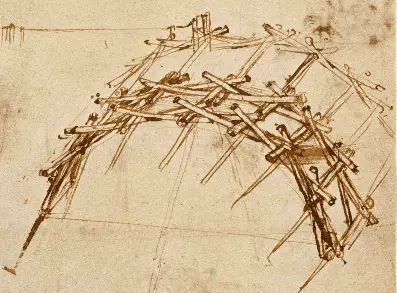

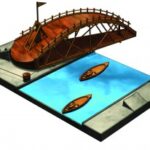
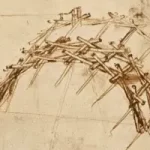
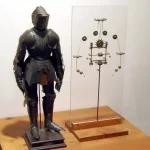
 Leonardo Bianchi,
the creator of Leonardo da Vinci's Inventions.
Thank you for visiting
Leonardo Bianchi,
the creator of Leonardo da Vinci's Inventions.
Thank you for visiting